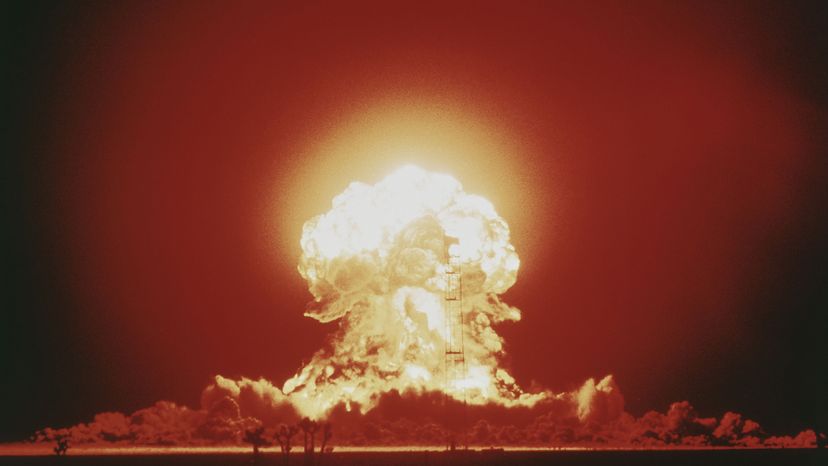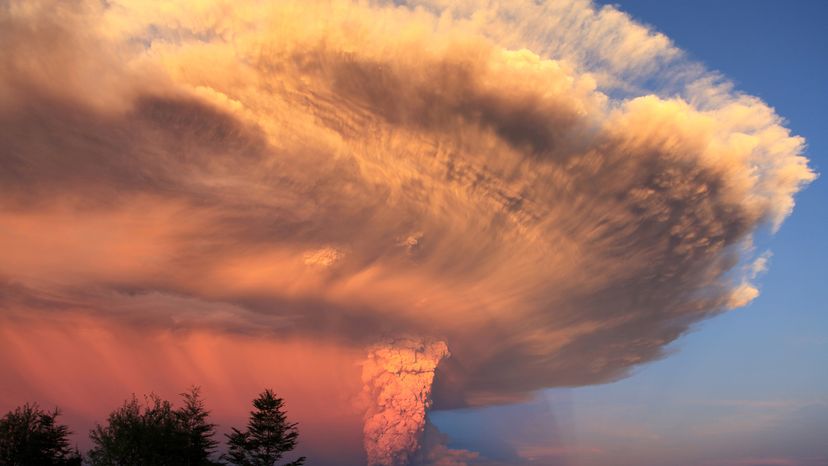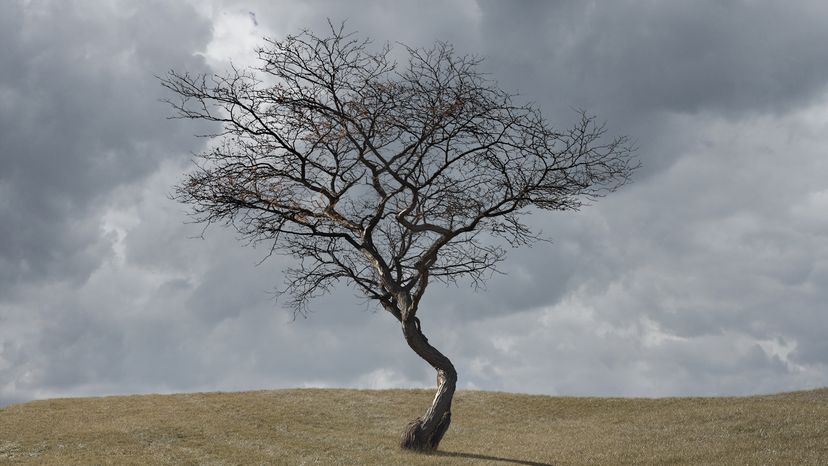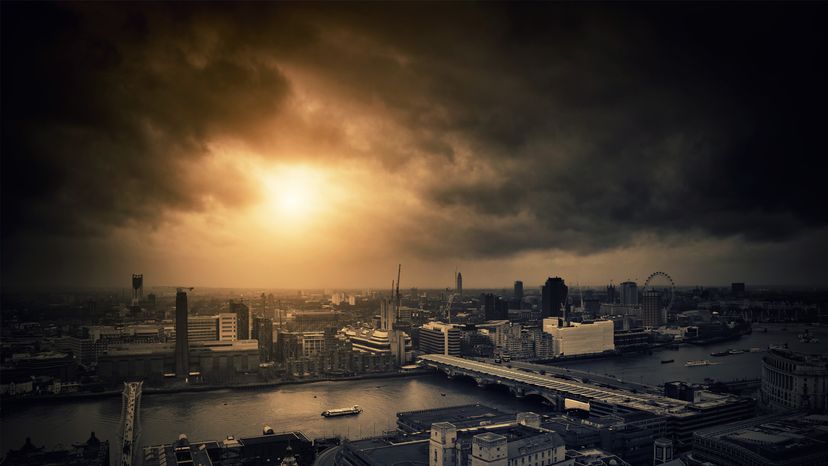
Call it paranoia or keen insight, but humans have long pondered the possibility that an apocalyptic event and potential nuclear winter won't come as the result of warring gods or cosmic mishap, but due to our own self-destructive tendencies. Once nomads in the primordial wilds, we've climbed a ladder of technology, taken on the mantle of civilization and declared ourselves masters of the planet. But how long can we lord over our domain without destroying ourselves? After all, if we learned nothing else from "2001: A Space Odyssey," it's that if you give a monkey a bone, it inevitably will beat another monkey to death with it.
Genetically fused to our savage past, we've cut a blood-drenched trail through the centuries. We've destroyed civilizations, waged war and scarred the face of the planet with our progress — and our weapons have grown more powerful. Following the first successful test of a nuclear weapon on July 16, 1945, Manhattan Project director J. Robert Oppenheimer brooded on the dire implications. Later, he famously invoked a quote from the Bhagavad Gita: "Now I am become death, the destroyer of worlds."
Advertisem*nt
In the decades following that detonation, humanity quaked with fear at atomic weaponry. As the global nuclear arsenal swelled, so, too, did our dread of the breed of war we might unleash with it. As scientists researched the possible ramifications of such a conflict, a new term entered the public vernacular: nuclear winter. If the sight of a mushroom cloud burning above the horizon suggests that the world might end with a bang, then nuclear winter presents the notion that post-World War III humanity might very well die with a whimper.
Since the early 1980s, this scenario has permeated our most dismal visions of the future: Suddenly, the sky blazes with the radiance of a thousand suns. Millions of lives burn to ash and shadow. Finally, as nuclear firestorms incinerate cities and forests, torrents of smoke ascend into the atmosphere to entomb the planet in billowing, black clouds of ash.
The result is noontime darkness, plummeting temperatures and the eventual death of life on planet Earth.
Advertisem*nt
Contents
- Nuclear War and the Atmosphere
- Forecast for Extinction
- Debating the End of the World
Nuclear War and the Atmosphere

The theory of nuclear winter is essentially one of environmental collateral damage. While a nuclear attack might target a nation's military infrastructure or population centers, the assault could inflict massive harm to Earth's atmosphere.
It's easy to take the air we breathe for granted, but the atmosphere is a vital component of all life on this planet. In fact, scientists believe it co-evolved to its present state along with Earth's unicellular organisms. It protects us from dangerous levels of solar radiation, but also allows the sun to heat our world. Sunlight shines through the atmosphere and warms the planet's surface, which then emits terrestrial radiation that heats the air.
Advertisem*nt
If sufficient ash from burning cities and forests ascended into the sky, it could effectively work as an umbrella, shielding large portions of the Earth from the sun. If you diminish the amount of sunlight that makes its way to the surface, then you diminish the resulting atmospheric temperature — as well as potentially interfere with photosynthesis.
Examples of this scenario have occurred on a smaller scale in recent history. For instance, the 1883 eruption of the Indonesian volcano Krakatoa blasted enough volcanic ash into the atmosphere to lower global temperatures by 2.2 degrees F (1.2 degrees C) for an entire year [source: Maynard]. Decades earlier in 1815, the eruption of Mount Tambora in Indonesia blocked enough sunlight around the globe to cause what came to be known as "the year without summer" [source: Discovery Channel]
That following year, residents in the United States experienced summer snows and temperatures between 5 and 10 degrees F (3 and 6 degrees C) less than average. This drop in temperatures devastated crops and caused hundreds of thousands of deaths — not counting those who perished in Indonesia.
Some archeologists theorize that an even greater cataclysm occurred 65 million years ago when an asteroid collided with Earth. Called the K-T boundary extinction event, some experts believe this collision may have ejected enough ash and debris into the atmosphere to cause an impact winter. The premise is the same as nuclear winter, only with a different method of generating the atmospheric debris. Some paleontologists suspect such an impact winter brought about the extinction of the dinosaurs.
Natural disasters aren't the only proven temperature changers. At the close of the 1991 Persian Gulf War, Iraqi President Saddam Hussein torched 736 Kuwaiti oil wells. The fires raged for nine months, during which average local air temperatures fell by 18.3 degrees F (10.2 degrees C) [source: McLaren].
As severe as these examples seem, nuclear winter theorists provided a far bleaker forecast should nuclear war erupt between the nuclear superpowers of United States and the then-Soviet Union. In the 1980s theorists predicted decade-long temperate decreases of as much as 72 degrees F (40 degrees C) [source: Perkins]. Such a winter could finish the destruction that nuclear war started, sending the survivors down a chilling path of famine and starvation.
Nuclear Winter and the Ozone
Some scientists predict that nuclear winter would be followed by an even harsher spring. They theorize that the sunlight bounced back up from the smoke clouds would heat up nitrogen oxides in the stratosphere. At high temperatures, the nitrogen oxides, which formed due to blast-burned oxygen, would deplete the ozone layer at much higher than normal rates.
Advertisem*nt
Forecast for Extinction

In Carl Sagan and Richard Turco's book "A Path Where No Man Thought," the two nuclear winter theorists propose six classes of nuclear winter, which provide a framework for understanding the possible atmospheric consequences of a global nuclear war.
- Minimal nuclear winter: In the best-case scenario for nuclear war, a small enough attack would cause minimal cloud cover and little or no environmental impact. While the damage sustained by targeted areas might prove substantial, the rest of the world wouldn't suffer atmospheric consequences.
- Marginal nuclear winter: Sagan and Turco predict a grim scenario for even a "marginal" nuclear winter. They calculate that a few nuclear detonations above urban centers in a contained nuclear war could lower temperatures in the Northern Hemisphere by a few degrees. Agricultural production would suffer, resulting in famine — especially if accompanied by severe drought. While a great deal of the ash would return to Earth in black rains, much would remain in the upper atmosphere. Sagan and Turco predict that the deaths from such a nuclear winter would equal those killed in the nuclear war. Everything below the equator would remain mostly unaffected, given the hemispheric separation of air currents and the fact that most nuclear targets exist in the Northern Hemisphere.
- Nominal nuclear winter: The authors deem this class of nuclear winter a low-end possibility for a full-scale nuclear war involving the detonation of between 6,000 and 12,000 nuclear weapons. Survivors would endure dark skies, widespread drought, fallout and global temperature drops of 18.3 degrees F (10 degrees C) in the Northern Hemisphere. Noon sunlight would be only one-third what it was before the war. In the following months, these clouds would dissipate, and the sun would seem to burn hotter than before. Because nuclear blasts would have destroyed much of the ozone layer, greater quantities of solar radiation would reach the Earth's surface. The Southern Hemisphere wouldn't experience major climatic change.
- Substantial nuclear winter: This scenario, following full-scale nuclear war, involves catastrophic consequences for the Northern Hemisphere: freezing temperatures, widespread fallout, pollution, ozone depletion and disrupted precipitation. Imagine a deeply overcast day — now imagine those conditions persisting for years. Green plants would barely receive enough sunlight for photosynthesis, affecting global food production. Crops would fail, billions of humans would die, species would go extinct and while humanity would likely survive, civilization as we know it might not. Damage to the Southern Hemisphere would depend on the number of detonations below the equator.
- Severe nuclear winter: In this scenario, less than 1 percent of the sun's light makes it to the Earth's surface for a period of months, resulting in temperature drops around the globe and insufficient light for photosynthesis. In addition to widespread famine and pollution, Sagan and Turco predict that agricultural production would be reduced to levels not seen since the Dark Ages.
- Extreme nuclear winter: In this worst-case scenario, based on the conditions in 1990, nearly all the world's nuclear weapons are deployed. The result would be utter darkness at noon. Much of the planet's life would perish within the chilly confines of this black, atmospheric tomb.
That said, nuclear winter is very much a theory — and a controversial one at that. However, nuclear winter research, like that being done by the Global Catastrophic Risk Institute, continues to reveal possible outcomes. Next, we'll look at how the theory has evolved and where it stands today.
Advertisem*nt
Debating the End of the World

The atmosphere is an incredibly complicated system. When you have 5.5 quadrillion tons (4.99 quadrillion metric tons) of gas and countless local, global, terrestrial and extraterrestrial factors stirring it into motion, it's difficult to understand how it all works. Even advanced computer models lose effectiveness when forecasting weather more than a few days. The use of these models gave birth to the notion of chaos theory and the Butterfly Effect. The smallest change can have enormous consequences, and there's at least a hint of the unpredictable to everything.
During the 1970s, the National Academy of Sciences and the U.S. Office of Technology Assessment deliberated the possible environmental effects of nuclear war, and in 1982, the Swedish Academy of Sciences published "The Atmosphere after a Nuclear War: Twilight at Noon." This report predicted that smoke from burning cities and forests might diminish sunlight — with dangerous consequences. In 1983, atmospheric scientist Richard Turco and astrochemist Carl Sagan joined three other scientists in publishing "Global Atmospheric Consequences of Nuclear Explosions." This article, known as the TTAPS report (short for the authors' names: Turco, Toon, Ackerman, Pollack and Sagan), generated a great deal of press. The United States and the Soviet Union gave the findings real consideration — which some attribute to calming trigger fingers during the Cold War.
Advertisem*nt
The TTAPS findings depend on 1980s computer weather models. But today, such technology is far from infallible. While most scientists agree that nuclear war would have some effect on the atmosphere, not everyone agrees on the severity. Author Michael Crichton accused the TTAPS authors of practicing "consensus science," in which speculation, public opinion and politics empower imperfect theories. Crichton argued that while consensus science may sell us something beneficial today, it sets a dangerous precedent for the future.
In 1990, the TTAPS authors published revised findings based on new data. The more moderate results appeased some critics, but there were — and are — still dissenting voices. These disagreements come down to four factors, each presenting its share of unknowns or unknowables:
- How much material is there to burn following a nuclear exchange?
- How much would remain in the atmosphere, and how much would fall back to the Earth's surface?
- How much sunlight would such smoke clouds deflect?
- During which season would the attack occur? If an attack occurred during the actual winter, might the results be far less severe?
As our understanding of the atmosphere improves, scientists continue to apply the data to the prospect of nuclear war. While it's easy to look at Cold War nuclear scenarios and discount nuclear winter as a threat in the 21st century, recent findings suggest we may be far from safe.
Using modern climate models, scientists Brian Toon and Alan Robock theorize that even a regional nuclear war could cause a marginal nuclear winter for everyone. According to their 2007 findings, if India and Pakistan were to each launch 50 nuclear weapons at each other, the entire globe could experience 10 years of smoke clouds and a three-year temperature drop of approximately 2.25 degrees F (1.25 degrees C) [source: Perkins]. Due in part to this report, the Bulletin of the Atomic Scientists advanced the Doomsday Clock two minutes closer to midnight.
We're not a full century into the nuclear age, but so far we've avoided even regional nuclear war. Will this stalemate hold out? Or will humans eventually get to test nuclear winter theories firsthand?
Advertisem*nt
Lots More Information
Related HowStuffWorks Articles
- How Fallout Shelters Work
- How Global Warming Works
- How the Nuclear Arms Race Works
- How Nuclear Bombs Work
- How the Ozone Layer Works
- How Weather Works
More Great Links
Sources
- Browne, Malcolm W. "Nuclear Winter Theorists Pull Back." New York Times. Jan. 23, 1990. (Dec. 29, 2008) http://query.nytimes.com/gst/fullpage.html?res=9C0CE3D91739F930A15752C0A966958260
- Chang, Kenneth. "Edward N. Lorenz, a Meteorologist and a Father of Chaos Theory, Dies at 90." New York Times. April 17, 2008. (Sept. 25, 2008) http://www.nytimes.com/2008/04/17/us/17lorenz.html?_r=2&scp=1&sq=edward%20lorenz&st=cse&oref=slogin
- "Dino impact gave Earth the chill." BBC News. May 31, 2004. (Dec. 29, 2008) http://news.bbc.co.uk/1/hi/sci/tech/3750765.stm
- "Evolution of the atmosphere." Britannica Online Encyclopædia. 2008. (Aug. 8, 2008) https://www.britannica.com/topic/evolution-of-the-atmosphere-1703862
- Keim, Brandon. "These ships could save the planet… and make great houseboats too." Wired Science. Oct. 9, 2007. (Dec. 29, 2008) http://blog.wired.com/wiredscience/2007/10/these-ships-cou.html
- McLaren, Duncan and Ian Willmore. "The environmental damage of war in Iraq." The Guardian. Jan. 19, 2003. (Dec. 29, 2008) http://www.guardian.co.uk/world/2003/jan/19/iraq5
- Robock, Alan. "Climatic Effects of Nuclear Conflict." Rutgers University. (Dec. 30, 2008) http://climate.envsci.rutgers.edu/pdf/iprc_climate_NW.pdf
- Saarman, Emily. "Return of Nuclear Winter." Discover. May 3, 2007. (Dec. 30, 2008) https://www.discovermagazine.com/environment/return-of-nuclear-winter
- Sagan, Carl and Richard Turco. "A Path Where No Man Thought." Random House. 1990.
- Sullivan, Michael. "How a Volcano Eruption Wiped Away Summer." NPR. Oct. 22, 2007. (Dec. 29, 2008) http://www.npr.org/templates/story/story.php?storyId=15448607
- Tarbuck, Edward and Frederick Lutgens. "Earth Science: Eleventh Edition." Pearson Prentice Hall. 2006.
- "The Trinity Test." U.S. Department of Energy. (Dec. 30, 2008) https://www.osti.gov/opennet/manhattan-project-history/Events/1945/trinity.htm
- Vogt, Gregory L. "The Atmosphere: Planetary Heat Engine." Twenty-First Century Books. 2007.
- Webber, Phillip. "Forecasting nuclear winter." Bulletin of the Atomic Scientists. October 2007.
